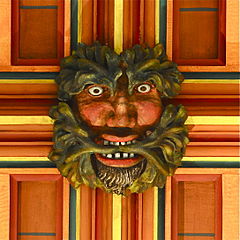We’re now in May and one reliable natural occurrence of the time of year is the flowering of common hawthorn (Crataegus monogyna), which is also known as the oneseed hawthorn, or single-seeded hawthorn.
Other common names include may, mayblossom, maythorn, quickthorn, whitethorn, motherdie, and haw.
The Woodland Trust have produced a short video depicting one year in the life of the hawthorn.
The specimen below can be found in the Easton section of the Bristol & Railway Path near the Brixton Road access point.

Hawthorn is amongst the first trees to start budding in the spring (the above specimen first put out leaves in late January. Ed.) and is also a fast-growing plant. This may explain the alternative name of quickthorn.
As it forms a dense, thorny mass of branches, it is often used for hedging, particularly where livestock has to be contained.
Besides its agricultural value as hedging, common hawthorn can support more than 300 insects. It is a food plant for caterpillars of numerous moths. Its flowers are eaten by dormice and provide nectar and pollen for bees and other pollinating insects. The haws (berries) are rich in antioxidants and are eaten by migrating birds, such as redwings, fieldfares and thrushes, as well as small mammals.
Furthermore, the dense, thorny foliage makes fantastic nesting shelter for many bird species of bird.

Folklore and symbolism
Hawthorn is a pagan symbol of fertility and has associations with May Day stretching back beyond written history. It was the forerunner of the Maypole and its leaves and flowers provided the source of May Day garlands as well as appearing in the wreath of the Green Man.
In medieval times hawthorn was never brought indoors as it was generally believed that bringing its blossom indoors would result in illness and even death. In those times it was also commonly believed that hawthorn blossom smelled like the plague. In more recent times scientists have discovered the chemical trimethylamine (which smells like ammonia or rotting flesh. Ed.) in hawthorn blossom is also one of the first chemicals formed in rotting animal fish, hence the tree’s traditional linking with illness and death.
In spite of the beliefs and symbolism outlined above, the young hawthorn leaves, flower buds and young flowers are all edible. The leaves are often described as having the flavour of bread and cheese. They can be added to green salads and grated root salads. The developing flower buds are particularly good. The haws can be eaten raw (beware a stomach upset. Ed.), but are most commonly used to make jellies and wines.
A final personal note
In my own life, the blossoming of the hawthorn always reminds me that spring is giving way to early summer.
In particular, it reminds of when I was 8 years old and my mother took my 2 younger siblings and me by train all the way from Stafford to Harling Road in Norfolk – the nearest station to my grandmother’s home. The journey took the best part of a day (showing how difficult it was to travel cross-country in England, even in pre-Beeching times. Ed.). The fields on either side of the railway lines on which we travelled were thick with hawthorn blossoming pink and white.
Whenever I see hawthorn in bloom these days, I’m immediately reminded of that one train journey, even though it’s now almost 6 decades in the past.
Update: After writing this post, I asked both my siblings if they remembered that journey and if so, what they recalled. My sister replied that she recollected the journey as being interminable and her chief memory was all the trackside telegraph poles, whilst my brother – the youngest of us – responded with a question as to whether that was the railway trip during which he was sick. He obviously had other matters than lineside shrubbery on his mind.
